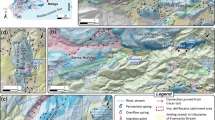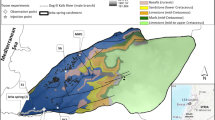Abstract
The goal of this paper is to develop a procedure of calculating karst conduit fluxes using dye tracing results. The Green’s function for the initial value problem is adapted by localized dilution at the juncture of conduit flows. Then the model is employed to simulate three breakthrough curves measured near Emerald Sink, Northwest Florida. The simulation of the tracing experiment from Cheryl Sink to Emerald Sink yields a recharge of 1.49 m 3/s at Emerald Sink. For the oxbow that connects Cheryl Sink with Emerald Sink, the major shortcut and the long side convey about 90 and 10% of water, respectively. The simulations of other two experiments yield a consistent value for the flow from a tributary conduit into the main conduit 200 m downstream of Emerald Sink, being 1.9–2.0 m 3/ s. The proposed theory is novel and robust in that the peak arrival time, time width, and amplitude of the measured curves are fully utilized, and the resulting water fluxes are independent of conduit radius.
Similar content being viewed by others
References
Birk S., Geyer T., Liedl R., Sauter M.: Process-based interpretation of tracer tests in carbonate aquifers. Ground Water 43(3), 381–388 (2005). doi:10.1111/j.1745-6584.2005.0033.x
Davies, G.J., Kincaid, T.R., Hazlett, T.J., Connolly, K.A., Jablonski, J.M.: Groundwater tracing as a means to collect data for groundwater model design and calibration. In: GSA 2002 Denver Annual Meeting, 27–30 October, Paper No. 101-7 (2002)
Davies, G.J., Kincaid, T.R., Hazlett, T.J., Loper, D.E., DeHan, R., McKinlay, C.: Why do quantitative groundwater tracing? Lessons and examples from the Woodville Karst Plain of North Florida. In: GSA 2004 Denver Annual Meeting, 7–10 November, Paper No. 49-22 (2004)
Field M.S.: The QTRACER program for tracer-breakthrough curve analysis for karst and fractured-rock aquifers. US Environmental Protection Agency, Washington, DC (2002)
Field M.S., Li G.: Inversion for the input history of a dye tracing experiment. J. Cave Karst Stud. 73(1), 16–20 (2011). doi:10.4311/jcks2010es0143
Field M.S., Pinsky P.F.: A two-region nonequilibrium model for solute transport in solution conduits in karstic aquifers. J. Contam. Hydrol. 44(3–4), 329–351 (2000)
Fischer H., List J., Koh C., Imberger J., Brooks N.: Mixing in Inland and Coastal Waters. Academic Press, New York (1979)
Geyer T., Birk S., Licha T., Liedl R., Sauter M.: Multitracer test approach to characterize reactive transport in karst aquifers. Ground Water 45(1), 36–45 (2007). doi:10.1111/j.1745-6584.2006.00261.x
Goldscheider N.: A new quantitative interpretation of the long-tail and plateau-like breakthrough curves from tracer tests in the artesian karst aquifer of Stuttgart, Germany. Hydrogeol. J. 16, 1311–1317 (2008). doi:10.1007/s10040-008-0307-0
Göppert N., Goldscheider N.: Solute and colloid transport in karst conduits under low- and high-flow conditions. Ground Water 46(1), 61–68 (2008). doi:10.1111/j.1745-6584.2007.00373.x
Hazlett-Kincaid, Inc.: Hydrogeological characterization and modeling of the Woodville Karst Plain, North Florida. Report of Investigations (2007)
Karst Environmental Services, Inc.: KES Projects-Discharge Measurement. http://www.karstenvironmental.com/projects_dm.html . Accessed 01 Jan 2011
Kreft A., Zuber A.: Physical meaning of dispersion equation and its solution for different initial and boundary conditions. Chem. Eng. Sci. 33(11), 1471–1480 (1978)
Li, G.: Laboratory simulation of solute transport and retention in a karst aquifer. Ph. D Dissertation, The Florida State University (2004)
Li G., Loper D.E.: Transport, dilution, and dispersion of contaminant in a leaky karst conduit. Transp. Porous Media 88, 31–43 (2011). doi:10.1007/s11242-011-9721-1
Li G., Loper D.E., Kung R.: Contaminant sequestration in karstic aquifers: Experiments and quantification. Water Resour. Res. 44, W02429 (2008). doi:10.1029/2006WR005797
NWFWMD.: Spring Inventory of the Wakulla and St. Marks Rivers: NWFWMD Water Resources Special Report 06-03. http://www.nwfwmd.state.fl.us/rmd/springs/Wakulla_StMarks/documents/data.htm . Accessed 4 February 2012
Strauss W.A.: Partial differential equations: an introduction. Wiley, New York (1992)
Taylor G.I.: The dispersion of matter in turbulent flow through a pipe. Proc. R. Soc. A 223, 446–468 (1954)
Toride N., Leij F.J., van Genuchten M.T.: A comprehensive set of analytical solutions for nonequilibrium solute transport with first-order decay and zero-order production. Water Resour. Res. 29(7), 2167–2182 (1993)
Toride, N., Leij, F.J., van Genuchten, M.T.: The CXTFIT code for estimating transport parameters from the laboratory or field tracer experiments, version 2.0. US Salinity Laboratory Research Report 137. US Salinity Laboratory, Riverside (1995), p. 121
Author information
Authors and Affiliations
Corresponding author
Rights and permissions
About this article
Cite this article
Li, G. Calculation of Karst Conduit Flow Using Dye Tracing Experiments. Transp Porous Med 95, 551–562 (2012). https://doi.org/10.1007/s11242-012-0061-6
Received:
Accepted:
Published:
Issue Date:
DOI: https://doi.org/10.1007/s11242-012-0061-6




